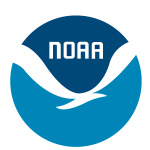- Industry: Government
- Number of terms: 30456
- Number of blossaries: 0
- Company Profile:
NOAA Coral Reef Conservation Program, National Oceanic and Atmospheric Administration, U.S. Department of Commerce
The detailed regulations that make up management measures; for example, trawl footrope size, depth limits, net mesh-size, etc.
Industry:Fishing
From research vessel surveys, for separate species of fish, each average catch per tow, determined from a series of tows, in each geographic stratum of a region is multiplied by that area (square nautical miles) of the stratum in which the tows are made. All of the individual products are added together and the total is divided by the sum of the entire area of the region. The final result is stratified mean catch per tow; this is used as an index of relative abundance. For example, a scientist wishes to calculate the stratified mean catch per tow of cod in a region (perhaps Georges Bank) that measures 100 square nautical miles. The region has been divided into 5 strata on the basis of depth. In each stratum, 5 tows are made and the average catch of cod is calculated.
Industry:Fishing
The distribution of one or more species that is defined by abiotic factors (temperature, salinity, surface currents, etc. ).
Industry:Fishing
Successive series of changes through which an organism passes in the course of its development.
Industry:Fishing
Monte Carlo simulation is a statistical approach whereby the inputs that are used for a calculation are resampled many times assuming that the inputs follow known statistical distributions. The Monte Carlo method is used in many applications such as Bayesian analyses, parametric bootstraps, and stochastic projections.
Industry:Fishing
Relationship between two species of animals in which one (the predator) actively hunts and lives off the meat and other body parts of the other (the prey).
Industry:Fishing
The quantity of fish caught (in number or in weight) with one standard unit of fishing effort; e.g. number of fish taken per 1,000 hooks per day or weight of fish, in tons, taken per hour of trawling. CPUE is often considered an index of fish biomass (or abundance). Sometimes referred to as catch rate. CPUE may be used as a measure of economic efficiency of fishing as well as an index of fish abundance. Also called: catch per effort, fishing success, availability.
Industry:Fishing
Indicates that the state of a fishery and/or a resource is approaching a target reference point (TRP) or a limit reference point (LRP), and that a certain type of action (usually agreed beforehand) needs to be taken. Fairly similar to a LRP in their utility, the ThRP specific purpose is to provide an early warning, reducing further the risk that the LRP or TRP are inadvertently passed due to uncertainty in the available information or inherent inertia of the management and industry systems. Adding precaution to the management setup, they might be necessary only for resources or situations involving particularly high risk.
Industry:Fishing
Water usable as inputs for economic production and livelihoods. A distinction is made between renewable and nonrenewable water resources. Nonrenewable water resources are not replenished at all or for a very long time by nature. This includes the so-called fossil waters. Renewable water resources are rechargeable due to the hydrological cycle unless they are overexploited, comprising groundwater aquifers and surface water like rivers and lakes.
Industry:Fishing
